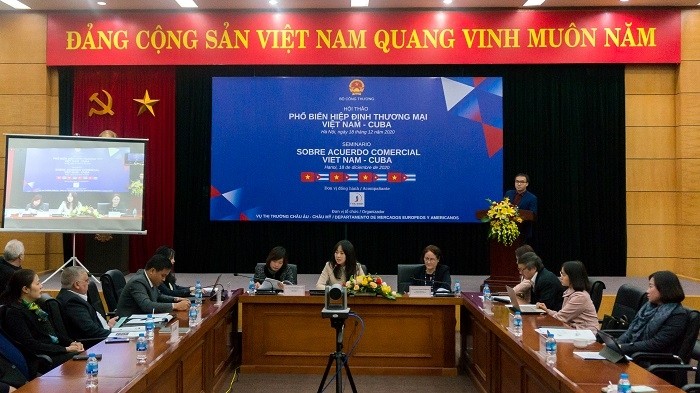The European-American Market Department under the Ministry of Industry and Trade (MoIT) held a seminar in Hanoi on December 18 to provide businesses with an insight into the Vietnam - Cuba Trade Agreement, the Latin American country’s first deal with an Asian partner.
The seminar was held to help local businesses learn of the commitments in the agreement and the challenges and opportunities in boosting exports to Cuba, thereby helping domestic businesses diversify their export markets, especially in the context of the COVID-19 pandemic having dealt a great blow to international trade.
Vo Hong Anh, Deputy Director of the MoIT’s European-American Market Department, said that the Vietnam-Cuba Trade Agreement was signed in Hanoi on November 9, 2018 and came into force on April 1, 2020. It is one of the achievements of the two sides' efforts to promote trade relations and develop these commensurate with the traditional political relationship of friendship between the two countries.
It consists of 14 chapters with regulations on trade in goods, rules of origin, customs management, trade facilitation, trade remedies, technical standards, conformity assessment procedures, sanitary and phytosanitary measures, and economic and trade cooperation.
In particular, as the two sides commit to eliminating or reducing tariffs on nearly 100% of imports within five years, the agreement is expected to generate benefits for business circles so as to lift bilateral trade to new heights. Enterprises can seize the opportunity and take advantage of the Cuban market as a transiting venue for Vietnam's exports to neighbouring regions and Latin American countries.
The agreement coming into effect with many tariff incentives would help Vietnamese businesses diversify their export structure thanks to applying these incentives, especially for Vietnam’s key commodities with greatest export potential.
In the agreement, the Cuban side applies special preferential import duties to Vietnam’s 794 tariff lines, including reducing up to 478 tariff lines to 0% from as soon as the agreement takes effect from April 1, 2020, applied to many strong products of Vietnam, including rice, grains, seafood, flowers, beans, construction materials, textiles, electrical appliances and medical equipment.
In addition, 296 tariff lines will be reduced to 0% (fresh vegetables and fruits, confectionery, seasoning, cosmetics, machinery, automation equipment, products from rattan and bamboo) and 20 lines reduced to 3-20% (synthetic and man-made fibers, screws, bolts, saw blades) after five years.
 |
Vo Hong Anh, Deputy Director of the European-American Market Department at the Ministry of Industry and Trade, speaking at the seminar.
According to Anh, the agreement is expected to raise the level of economic and trade cooperation between Vietnam and Cuba step by step, to a par with the positive bilateral political relationship. This is entirely possible as Cuba is a market with stable GDP growth, with a non-competitive import-export structure that is mainly complementary to the production and consumption needs of Vietnam, she added.
Khong Thanh Phong, Second Secretary and Head of the Trade Office under the Vietnamese Embassy in Cuba, said that Vietnam is Asia's second largest trading partner with Cuba and the largest Asian investor in the Caribbean nation. The two sides' trade exchanges have steadily increased annually, averaging US$250-300 million each year. Currently, Vietnam has four projects licensed in Cuba with a total registered capital of tens of millions of USD.
According to Phong, there is plenty of room for Vietnamese goods to enter the Cuban market, because Vietnam's export structure accounts for only about 3% of Cuba's total import-export turnover. In addition, there exist many advantages of and opportunities for cooperation with Vietnamese businesses as the two countries have a good traditional friendship. Cuba is also applying more open economic - trade policies to create opportunities for foreign investors. Vietnamese goods enjoy preferential tariffs when exported to Cuba under the bilateral trade agreement, while the Cuban market is not too strict when compared with other demanding markets.
Irmina Perojo Bellido de Luna, Commercial Counselor of the Cuban Embassy in Vietnam, said that Cubans have good sentiment for and trust in goods from Vietnam, including those that are Vietnam's strength and are in high demand in Cuba, including food, commodity groups serving people's lives (clothing, textiles) and production (construction materials, cement, furniture, home appliances, ceramics, input materials, especially for pharmaceutical production).
At the seminar, representatives from domestic business associations and local enterprises were also provided with updated information on the Cuban market. Delegates shared experiences, as well as discussing opportunities and challenges for Vietnamese businesses in the Cuban market.
They were also offered solutions to help businesses orient their approach strategy to this potential market and at the same time make effective use of the incentives that the agreement offers, including the application of rules of origin to enjoy preferences when exporting goods to the Cuban market.
According to Anh, although the bilateral trade relationship is still facing a number of difficulties and challenges, as well as the complicated development of the COVID-19 epidemic, the opportunity for businesses to expand their market is positive within the context of the preferential treatment contained in the Vietnam-Cuba Trade Agreement.
The MoIT, together with relevant ministries, agencies and the Vietnam Trade Office in Cuba, will be a bridge to support the Vietnamese business community in the provision of market information and connecting with Cuban partners to support and resolve difficulties arising in market access and the operation of enterprises, she affirmed.
Trade between Vietnam and Cuba stood at US$226.81 million in 2019, including US$221.62 million in exports from Vietnam. The figure reached US$102 million in the first 10 months of this year, with US$100 million attributable to Vietnamese shipments.
Rice, coffee, chemical products, apparel, and footwear are major exports, with the country primarily importing vaccines and pharmaceuticals from Cuba.















